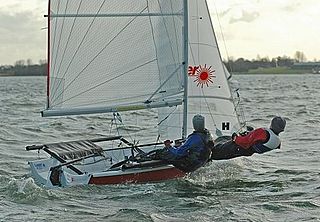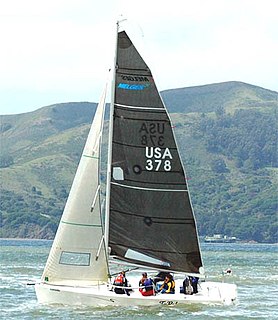
Dinghy sailing is the activity of sailing small boats by using five essential controls:

A Streaker is a type of sailing dinghy designed in 1975 by Jack Holt. It is a light one-person boat with a uni-rig stayed sail plan. It is sailed mainly in Britain and the Philippines, and over 1800 have been built. At first all boats were built of plywood, but since 1998 fibreglass, and fibreglass variants have been used, and now over half of new boats are of fibreglass or composite construction.
This is a glossary of nautical terms; some remain current, while many date from the 17th to 19th centuries.

Proas are various types of multi-hull outrigger sailboats of the Austronesian peoples. The terms were used for native Austronesian ships in European records during the Colonial era indiscriminately, and thus can confusingly refer to the double-ended single-outrigger boats of Oceania, the double-outrigger boats of Island Southeast Asia, and sometimes ships with no outriggers or sails at all.

Hobie Cat is a company that manufactures sailing catamarans, surfboards, sailboats, kayaks, stand-up paddle boards, and pedalboards as the Hobie Cat Company. It was founded in 1961 by Hobart Alter, who originally manufactured surfboards. Its line of products has included more than twenty sailing craft, plus a variety of other watercraft.

The Phantom Freighter is Volume 26 in the original The Hardy Boys Mystery Stories published by Grosset & Dunlap.

The Laser 4000 is a racing dinghy designed by Phil Morrison crewed by two persons. Its one-design weight-equalised system enables physically differing sailors to compete on a level playing field. It is most popular in Europe, particularly the UK, France and Italy.

Jubilee Sailing Trust is a charitable organisation in the United Kingdom which owns and until 2019 operated two square-rigged three-masted barques, the STS Lord Nelson and the SV Tenacious.

Otter is a classification referring to a particular design for a two-man sailing dinghy with a glass fibre hull. Its rig consists of a main, a jib and an optional symmetric spinnaker. The hull dimensions are 11 ft 11 in length and 4 ft 10 in beam. The boat has a draft of 3 ft 6 in with the centreboard down. The sail area is 75 sq. ft. The class symbol is a stylised glass bubble; due to the original lightweight "cigar box cedar" construction of the prototypes, the name 'Bubble' was first used for the boat. John Baker obtained the plans for an expanded version of the boat in G.R.P. and hence renamed the boat 'Glass Bubble'. After being put into production by Baker, the name 'Otter' was adopted; coming from the river of the same name in East Devon, close to where the boat was manufactured.

The 12 ft Skiff is a development dinghy class dating back to the early 20th century. It is sailed in Australia and New Zealand. It is 12 ft (3.7 m) in length, hence the name, and is a two-man boat. Both the crew and the helm are able to use the trapeze at the same time. It has an asymmetrical spinnaker and a jib, in addition to the mainsail.

The Laser 3000 is a racing sailing dinghy crewed by two persons with a trapeze for the crew. Launched in 1996, the 3000 was developed from the Laser 2, using the original Frank Bethwaite-designed planing hull combined with a brand new self-draining deck by Derek Clark. Clark also re-designed the rig, using spars and sails from premium proprietary sources and replacing the symmetric spinnaker of the Laser 2 by a larger asymmetrical spinnaker. The gennaker is chute-launched and retrieved using a single halyard line, and is set on a retractable bowsprit. Helm balance and handling were improved using a shorter-footed mainsail with two full-width battens giving a larger roach. A mast with conventional spreaders replaced the now-unusual diamond arrangement of the Laser 2.

The 3000 is a racing sailing dinghy crewed by two persons with a trapeze for the crew. Launched in 1996 as the Laser 3000, the 3000 was developed from the Laser 2, using the original Frank Bethwaite-designed planing hull combined with a new designed self-draining deck by Derek Clark. Clark also re-designed the rig, using spars and sails from premium proprietary sources and replacing the symmetric spinnaker of the Laser 2 by a larger asymmetric spinnaker (gennaker). The gennaker is chute-launched and retrieved using a single halyard line, and is set on a retractable bowsprit. Helm balance and handling were improved using a shorter-footed mainsail with two full-width battens giving a larger roach. A mast with conventional spreaders replaced the now-unusual diamond arrangement of the Laser 2.

The Bermuda Fitted Dinghy is a type of racing-dedicated sail boat used for competitions between the yacht clubs of Bermuda. Although the class has only existed for about 130 years, the boats are a continuance of a tradition of boat and ship design in Bermuda that stretches back to the earliest decades of the 17th century.

The term sportsboat first appeared in the late 1980s and early 1990s to describe trailer sailers that were optimised for high performance at the expense of accommodation and ballast. The very definition of the term "sportsboat" is evolving.
Angus Primrose was a designer and naval architect, whose best known designs for around the world races included Sir Francis Chichester's Gypsy Moth IV and Galway Blazer II (1969) of Commander Bill King.

The RS400 is a light-weight sailing dinghy designed by Phil Morrison and manufactured by RS Sailing. The dinghy is sailed by two people and has a main, a jib and an asymmetric spinnaker. It has a PY of 948 and a D-PN of 82.3.

STV Black Jack is a brigantine operated by the Ottawa-based youth charity Bytown Brigantine, Inc. Black Jack sails on the Ottawa River between Brittania Yacht Club and Quyon, Quebec. On May 2, 2004, STV Black Jack was designated "Ottawa's Signature Tall Ship".
ISO is an International Sailing Federation (ISAF) class of two-person sailing dinghy with a single trapeze and an asymmetric spinnaker. The ISO was designed in 1993 by Ian Howlett and John Caig and manufactured by Reg White Limited of Brightlingsea as part of the "White Formula" range of boats originally marketed by Topper International Ltd and since 2013 by Vantage Sailing Ltd. The boat has a fully battened mainsail, jib and an asymmetric spinnaker.
The Topaz Magno is a Sailing dinghy created by Topper International designed for between 1 and 4 crew members, though usually 2.
This is a list of nautical terms starting with the letters M to Z.














